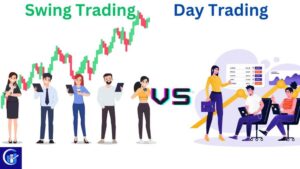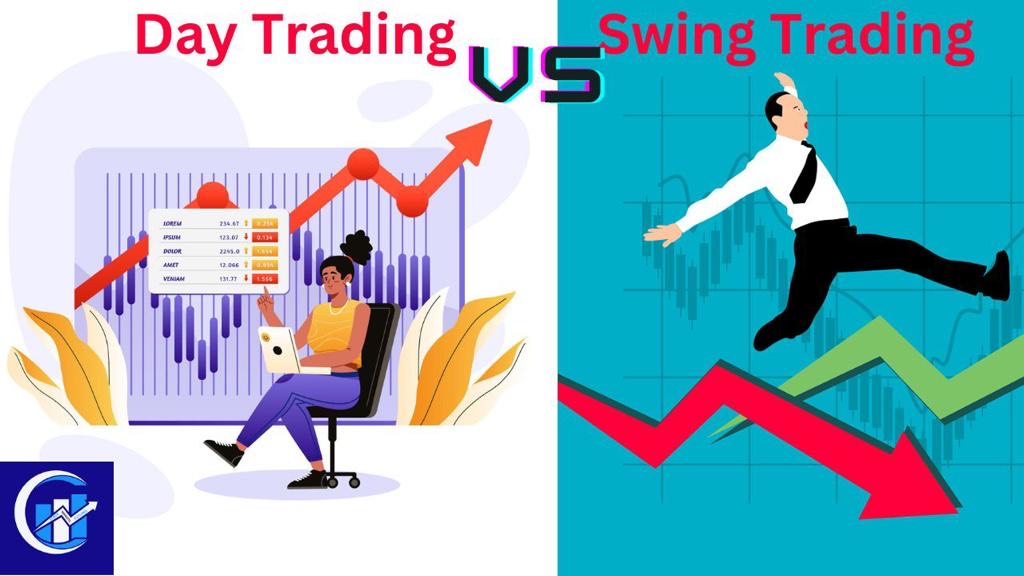Day Trading vs. Swing Trading- What’s the Difference?
When it comes to trading in the financial markets, there are various techniques that traders appoint to are trying to find profits. Two best techniques are swing trading and day trading. Each has its very own unique advantages and risks. In this article, we’ll explore swing trading and day trading. We’re going to explore swing buying and selling and day trading, evaluating the two to help you determine which is probably the proper suit for your trading style and goals.

Swing Trading: Riding the Market Waves
Swing buying and selling is a trading method that objectives to capture price swings or “swings” in a security’s price over a short to medium-term time frame. Unlike day buying and selling, swing buyers typically hold positions for several days or even weeks, in search of to profit from both upward and downward rate movements. Here are some key functions of swing buying and selling.
1.Longer Holding Periods
Swing investors regularly preserve positions for days or weeks, allowing them to journey out short-time period price fluctuations and avoid the stress of constantly monitoring the markets all through the day.
2.Less Time-Intensive
Swing trading doesn’t require traders to be glued to their screens all day. It allows for a more relaxed trading approach, making it suitable for individuals with full-time jobs or other commitments.
3.Emphasis on Technical Analysis
Technical analysis plays a vital position in swing buying and selling. Traders use various technical signs and chart styles to pick out ability access and go out points. This methodical method allows in making knowledgeable trading decisions.
4.Lower Transaction Costs
Swing traders typically make fewer trades compared to day traders, which can result in lower transaction costs, such as commissions and spreads.
5.Overnight Risks
One downside of swing trading is the exposure to overnight risks. Holding positions overnight means you’re subject to potential market gaps or news events that can significantly impact your positions.
Day Trading: The Thrill of Quick Moves
Day trading is a method wherein consumers open and close to positions within the same trading day, aiming to take gain of intraday price movements. It requires a high level of focus, discipline, and a solid trading plan. Here are some key talents of day trading.
1.Quick Decision-Making
Day traders must make rapid decisions in a fast-paced environment. This trading style can be exhilarating but also mentally demanding.
2.No Overnight Risk
Since day traders close all their positions by the end of the day, they are not exposed to overnight risks caused by unexpected news or events.
3.Intraday Profits
Day traders aim to capture small price movements throughout the day, potentially accumulating profits from multiple trades. These gains can add up over time.
4High Transaction Costs
Day trading involves frequent buying and selling, leading to higher transaction costs. Commissions and bid-ask spreads can eat into profits.
5.Continuous Market Monitoring
Day traders need to closely monitor the markets during trading hours. This can be challenging for those with other commitments or limited time.

Which Is Right for You?
Deciding between swing trading and day trading ultimately comes down to your personal preferences, lifestyle, risk tolerance, and trading goals. Here are some factors to consider when making your choice.
1.Time Commitment
Ask yourself how much time you can realistically dedicate to trading. Swing trading is more suitable for those with limited daily availability, while day trading demands your full attention during market hours.
2.Risk Tolerance
Consider your risk tolerance. Day trading can be riskier due to its fast-paced nature and potential for larger losses in a short time. Swing trading, with its longer holding periods, may provide more room for market fluctuations.
3.Psychological Stamina
Day trading requires strong emotional control and discipline. If you thrive in high-pressure situations and can handle quick decision-making, day trading may be appealing. Swing trading offers a less intense experience.
4.Financial Resources
Evaluate your financial resources, including trading capital. Day trading may require a larger account size to accommodate frequent trades, whereas swing trading can be done with less capital.
5.Learning Curve
Both swing buying and selling and day trading require a solid knowledge of the markets, technical analysis, and risk management control. Consider your willingness to invest time in studying and practicing your chosen approach.
FAQS
1.Does day trading possess less risk than swing trading?
Day trading plays on smaller price movements, so the risk is lower than swing trading. When day traders make multiple trades in a single trading day, there are chances of gaining numerous small profits and losses.
2.What is the major difference between day traders and swing traders?
The major difference between day traders and swing traders is the pattern. Swing traders hold their positions based on the market movement to earn a bigger profit.
At the same time, day traders base their trading decisions on several technical, quantitative, and fundamental analyses and identify stocks that gain or lose during the trading day.
3.What is Day Trading?
Day trading is the activity of buying and selling financial instruments like stocks, bonds, futures, or commodities to generate profit from the price movement within a single trading day.
Goals
Your trading goals play a crucial role in your choice. Are you looking for short-term gains or are you comfortable with a more patient approach? Define your objectives clearly.
Conclusion
In the world of trading, there may be no person-length-suits-all approach. Swing trading and day trading every provide precise opportunities and demanding situations. It’s essential to assess your lifestyle, risk tolerance, and financial resources before deciding which strategy aligns best with your goals.
Remember that successful trading calls for non-stop studying, area, and adaptability. Whichever direction you choose, be organized to invest time and effort in honing your competencies and dealing with your risk efficaciously. Whether you choose the slower pace of swing trading or the pleasure of day trading, the important thing to success lies to your dedication and approach. Happy buying and selling.

2 thoughts on “Day Trading vs. Swing Trading- What’s the Difference?”